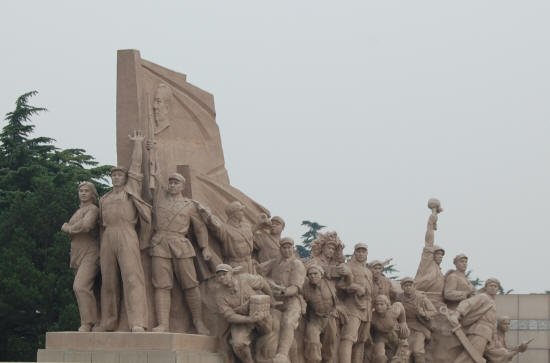Beijing - Tiananmen Square

Revolution Monument in Tiananmen Square - Beijing
Tiananmen Square Photo Gallery (Downloadable Pictures)
Tiananmen Square is a large city square in the center of
Beijing, China, named after the Tiananmen Gate (Gate of
Heavenly Peace) located to its North, separating it from the
Forbidden City. Tiananmen Square is the second largest city
square in the world (440,000 m² - 880m by 500m). It has
great cultural significance as it was the site of several
important events in Chinese history. Outside China, the
square is best known in recent memory as the focal point of
the Tiananmen Square protests of 1989, a pro-democracy
movement which ended on 4 June 1989 with the declaration of
martial law in Beijing by the government and the death of at
least hundreds of protesters.
The Tiananmen Gate to the Forbidden City was built in 1415
during the Ming Dynasty. Towards the demise of the Ming
Dynasty, heavy fighting between Li Zicheng and the early
Qing emperors damaged (or perhaps destroyed) the gate. The
Tian'anmen square was designed and built in 1651, and has
since enlarged four times its original size in the 1950s.
Near the centre of today's square, stood the "Great Ming
Gate", the southern gate to the Imperial City, renamed
"Great Qing Gate" during the Qing Dynasty, and "Gate of
China" during the Republic of China era. Unlike the other
gates in Beijing, such as the Tiananmen and the Qianmen,
this was a purely ceremonial gateway, with three arches but
no ramparts, similar in style to the ceremonial gateways
found in the Ming Dynasty Tombs. This gate had a special
status as the "Gate of the Nation", as can be seen from its
successive names. It normally remained closed, except when
the Emperor passed through. Commoner traffic was diverted to
two side gates at the northern and eastern ends of today's
square, respectively. Because of this diversion in traffic,
a busy marketplace, called Chessgrid Streets developed in
the big, fenced square to the south of this gate.
British and French troops who invaded Beijing in 1860
pitched camp near the gate and briefly considered burning
down the gate and the entire Forbidden City. They decided
ultimately to spare the palace and to burn instead the
emperor's Old Summer Palace. The Qing emperor eventually
agreed to let the foreign powers establish headquarters in
the area. During the Boxer Rebellion of 1900 the siege badly
damaged the office complexes and several ministries were
burnt down. In the conflict's denouement, the area became a
space for foreign troops to assemble their armies and
horses.
In the early 1950s, the Gate of China was demolished,
allowing for the enlargement of the square. In November 1958
a major expansion of Tiananmen Square started, which was
completed after only 10 months, in August 1959. This
followed the vision of Mao Zedong to make the square the
largest and most spectacular in the world, and intended to
hold over 500,000 people. In that process, a large number of
residential buildings and other structures have been
demolished. On its southern edge, the Monument to the
People's Heroes has been erected. Concomitantly, as part of
the Ten Great Buildings constructed between 1958-59 to
commemorate the ten year anniversary of the People's
Republic of China, the Great Hall of the People and the
Revolutionary History Museum (now National Museum of China)
were erected on the western and eastern sides of the square.
The year after Mao's death in 1976, a Mausoleum was built
near the site of the former Gate of China, on the main
north-south axis of the square. In connection with this
project, the square was further increased in size to become
fully rectangular and being able to accommodate 600,000
persons.
The urban context of the square was altered in the 1990s
with the construction of National Grand Theatre in its
vicinity and the expansion of the National Museum.
(Wikipedia)